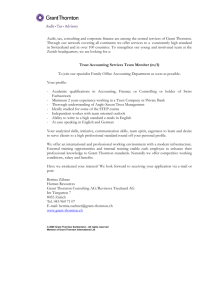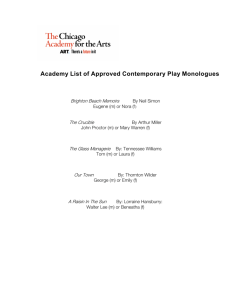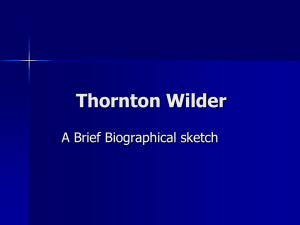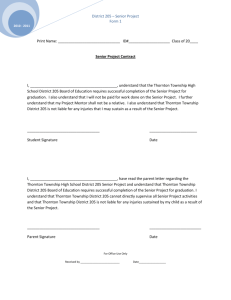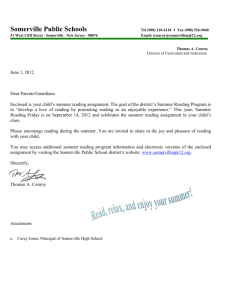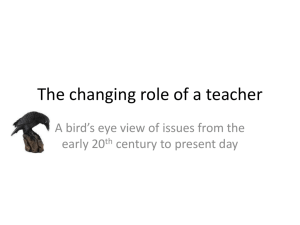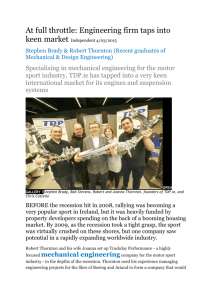thorntonsyllabusatlantichistoryspring2016 - H-Net
advertisement
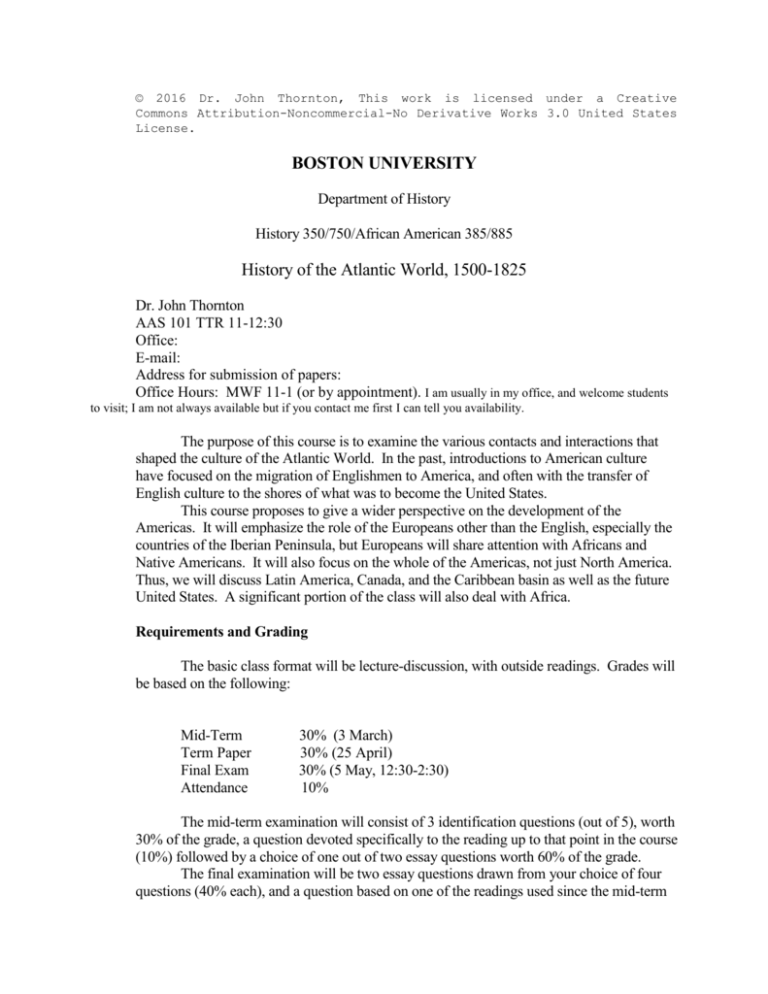
© 2016 Dr. John Thornton, This work is licensed under a Creative Commons Attribution-Noncommercial-No Derivative Works 3.0 United States License. BOSTON UNIVERSITY Department of History History 350/750/African American 385/885 History of the Atlantic World, 1500-1825 Dr. John Thornton AAS 101 TTR 11-12:30 Office: E-mail: Address for submission of papers: Office Hours: MWF 11-1 (or by appointment). I am usually in my office, and welcome students to visit; I am not always available but if you contact me first I can tell you availability. The purpose of this course is to examine the various contacts and interactions that shaped the culture of the Atlantic World. In the past, introductions to American culture have focused on the migration of Englishmen to America, and often with the transfer of English culture to the shores of what was to become the United States. This course proposes to give a wider perspective on the development of the Americas. It will emphasize the role of the Europeans other than the English, especially the countries of the Iberian Peninsula, but Europeans will share attention with Africans and Native Americans. It will also focus on the whole of the Americas, not just North America. Thus, we will discuss Latin America, Canada, and the Caribbean basin as well as the future United States. A significant portion of the class will also deal with Africa. Requirements and Grading The basic class format will be lecture-discussion, with outside readings. Grades will be based on the following: Mid-Term Term Paper Final Exam Attendance 30% (3 March) 30% (25 April) 30% (5 May, 12:30-2:30) 10% The mid-term examination will consist of 3 identification questions (out of 5), worth 30% of the grade, a question devoted specifically to the reading up to that point in the course (10%) followed by a choice of one out of two essay questions worth 60% of the grade. The final examination will be two essay questions drawn from your choice of four questions (40% each), and a question based on one of the readings used since the mid-term (20%). Students should attend all classes. If you must miss an examination or test inform me in advance, if possible. I expect all students to complete all work, so if you miss an exam, for any reason, schedule a make up session after discussing the absence with me. The class readings are either from the books, available for purchase at the BU Bookstore, or the other readings, which are all available in PDF format at the class website found at Blackboard Learn, the course website. The paper will be a 10-12 page (3,500-4,200 words) research paper. The topic of the paper will be open to any issue raised in the course, or that relates to any matter that took place in the Atlantic world in the period 1500-1825, even if it was not explicitly discussed in class. It is my intention that term papers be based on a thesis. That is, each student should consider a controversial question that the history of this region and time period raises and propose an answer to it. The paper will then be a defense of the answer or thesis, in which data are arrayed to show why the thesis is true. All students should supply me with written notice of their paper topic and thesis, as well as a brief bibliography. Although this will not be graded, it can provide me with a vehicle for helping you and allowing you to get your thoughts together. For best results, you should submit this proposal to me on or before 14 March (the day we return from Spring Break). Submit the proposal and the final paper to me by e-mail in Word or another compatible format like RTF (please change formats if you use an iPad). Do not submit these to my Boston University Account, but to _____. I will then mark these files and return them to you by e-mail. If you have reasons to believe you cannot turn the paper in by its due date, inform me and discuss options. Late papers will be assessed a grade reduction of one third of a grade (ie an A becomes an A-) for each class sessions that the paper is late, but no paper will fail simply because of lateness. Please insure that your work and conduct reflect standards expected of students at Boston University, and consult the Academic Conduct Code, found at http://www.bu.edu/cas/students/undergrad-resources/code (for undergrads) and http://www.bu.edu/cas/students/grad-resources/forms/discipline (for grad students). Course Texts John Thornton, A Cultural History of the Atlantic World, 1250-1820 (Cambridge University Press, 2012) David G. Sweet and Gary B. Nash, eds. Struggle & Survival in Colonial America (University of California Press, 1981). Course Outline and Reading Assignments Topic 1 The Formation of the Atlantic World Thornton to p. 28 Read: Jack Forbes, Africans and Native Americans, pp. 1-25. Part I. The Old Worlds Topic 2. The European Background Thornton, 29-59 Read: Clifford J Rogers, “The Military Revolution of the Hundred Years’ War,” The Journal of Military History 57 (1993): 241-78. John Appleby, “War, Politics, and Colonization,” in Nicholas Canny, ed. The Oxford History of the British Empire. Volume I. The Origins of Empire (Oxford, 1998), pp. 55-78. Topic 3 The African Background Thornton, 60-99 Read: Joseph C. Miller, “Central Africa During the Era of the Slave Trade,” in Heywood, Central Africans, pp. 21-70. Kristen Mann and Robin Law, “West Africa in the Atlantic Community: The Case of the Slave Coast,” William & Mary Quarterly 3rd series, 52 (1999): 307-34. Topic 4 The American World Thornton, 100-156 Read: William Starna and Ralph Watkins, "Northern Iroquoian Slavery," Ethnohistory 38 (1991): 34-57. Terence N. D’Altroy, “Politics, Resources, and Blood in the Inka Empire,” in Susan Alcock, Terence D’Altroy, Kathleen Morrison and Carla Sinopoli, eds. Empires: Persepctives from Archaeology and History (Cambridge University Press, 2001), pp. 200226. \ Part II. The Nature of Encounter and its Aftermath Topic 5 Conquest Thornton, 157-211 Read: Ross Hassig, “War, Politics and the Conquest of Mexico,” in Jeremy Black (ed.) War in the Early Modern World, 1450-1815 (London, 1999), pp. 207-35. William T. Sanders and Barbara Price, “The Native Aristocracy and the Evolution of the Latifundio in the Teotihuacán Valley, 1521-1917,” Ethnohistory 50 (2003): 69-88. Sweet and Nash, pp. 214-27; 247-56; 298-346; 362-75 Topic 6 Colonization Thornton, 212-247 Heywood, Central Africans, pp. 91-116 Daniel Usner, Indians, Settlers, and Slaves in a Frontier Exchange Economy, pp. 44104. Sweet and Nash, 1-37; 228-246; 256-91; 376-91. Topic 7 Contact Thornton, 248-311 Read: Heywood, 227-42 John Thornton, “Angolan States and the Formation of Palmares (Brazil)” (published as “Les États de l’Angola et la formation de Palmares (Brésil),”Annales: Histoire, sciences sociales 63/4 (2008): 769-97) Marcus Rediker, “’Under the Banner of King Death’: The Social World of AngloAmerican Pirates, 1716-1726,” William & Mary Quarterly 38 (1981): 203-27. Sweet and Nash, pp. 165-88; 347-61. Part III. Culture Transition and Change Topic 8 Transfer and Retention in Language. Thornton, 313-341 Read: David Hackett Fisher, Albion's Seed, pp. 207-310. James Lockhart, The Nahuas After the Conquest (Stanford University Press, 1992), pp. 261-325. Topic 9 Aesthetic Change Thornton, 342-96 Read: Richard Rath, "African Music in Seventeenth Century Jamaica: Cultural Transit and Transmission," William and Mary Quarterly 50 (1993): 700-26. James Lockhart, The Nahuas After the Conquest, pp. 374-426. Topic 10 Religious Stability and Change Thornton, 397-463 Read: Heywood, Central Africans, 71-90; 243-88. Robert Moss, "Missionaries and Magicians: The Jesuit Encounter with Native American Shamans on New England's Colonial Frontier," in Peter Benes (ed.) Wonders of the Invisible World: 1600-1900, pp. 17-33. Sweet and Nash, pp. 38-48; 102-164; 189-207. Topic 11 The Revolutionary Moment in the Atlantic Thornton, 464-524 Read: Bruce Johansen and Elizabeth Tooker, "Commentary on the Iroquois and the U. S. Constitution," Ethnohistory 37 (1990): 279-97. Sweet and Nash, pp. 49-101 Translations of quotations in Forbes, Africans and Native Americans p. 13 (Latin) starting "Nepos de septentrionali..." is actually translated on top of p. 13. p. 14 (Spanish) "trajeron pañezuelos..." They wore well made and woven little cloths of cotton, with colors and patterns like those brought from Guinea, from the "Rivers" to Sierra Leone [two districts on the west coast of Africa], without any difference, and he said that they ought not to be in communications with those, as from there to where he now is, is more than 800 leagues; later he said they resembled almaizares [Moorish scarves]. second quotation (Spanish) "experimentar lo que..." find out if what the indios of Espaniola say, that a black people come up from the south and southeast, who have azagayas [a type of spear] whose points are made from a metal which they call guanín, those which were sent to the kings were assayed, from which they learned that of 32 parts, 18 were gold, 7 of silver, and 8 of copper. p. 15 (Spanish) "como lo que aquí..." according to what he said he meant there was an island called Guanin where they had much gold, and they did not have much guanin anywhere, and this was a certain type of base gold which they called guanin, which is somewhat purple, which they know and esteem it by its smell. second quotation (Italian) "Non hanno..." They do not have ships nor have they even seen them, except after they had knowledge of the Portuguese. The truth is that those who live above this river, and those who live along the seacoast have some zoppoli [little boats], which are almadie [canoes] made all of one log, which carry three or four men at most for the largest, and with these they go out to fish and cross the river and go from place to place. p. 16 (Spanish) "encontraron allí esclavos..." They met black slaves here from a region which was only two days journey from Cuarecua, in which they have many blacks, and these fierce and above all cruel. They think that in another time blacks crossed from Ethiopia to rob and getting shipwrecked, established themselves in these mountains [or remote areas]. The people of Cuarecua bore these blacks an intense hatred, and they enslaved or killed each other. p. 17 In middle of passage... (Italian) "vi hanno...: they have begun to plant this plant which within a year became almost as tall as a tree, and it gives fruit like the figs of Alexandria in Egypt, as I noted, which they call musas and in this island they want abellana. second place (Portuguese) "Pacoba é uma fruta..." Pacoba is a fruit native to this country, which gives a very soft and easy to cut tree...in India they call these pacoba trees fig trees and the fruit figs...and the natives call these pacobas bacobuçú, which is to say a great pacoba. There is another species, which the Indians call pacobamirim which is to say little pacobas. p. 23 (Spanish) "el acabará..." in a very short time he finished using up all the people of this island [Haiti], because he was determined to load the ships that went to Castille with slaves and send them to be sold at the Canary Islands, and the Azores, and Cape Verde where they were much in demand, and it was on this merchandise that the financial means to supply the needs and expenses of this conquest was founded, and to pay off the expenses that the kings [Ferdinand and Isabel] had first laid out.
